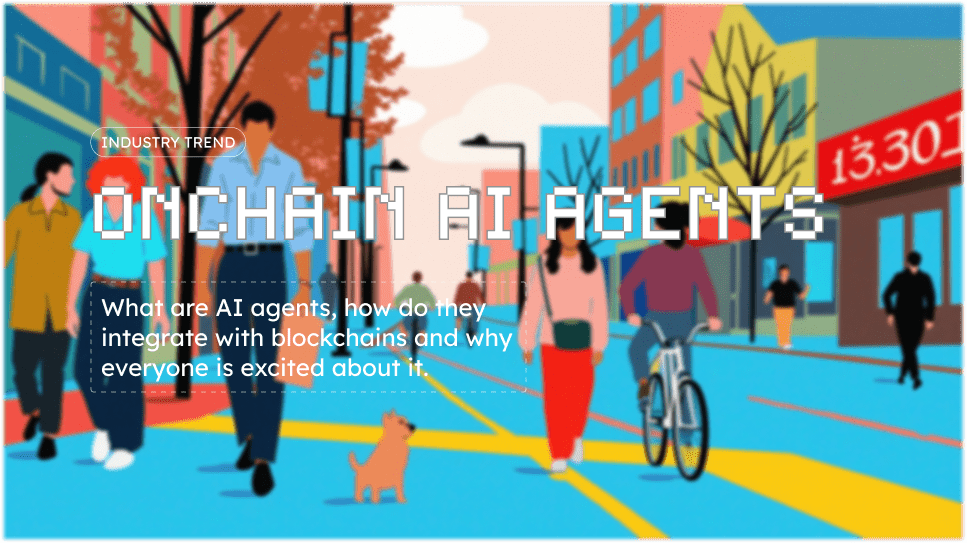
Blockchain and artificial intelligence are converging in groundbreaking ways, with onchain AI agents emerging as a transformative force in decentralized finance (DeFi), gaming, and digital asset management. These autonomous programs combine AI’s decision-making prowess with blockchain’s transparency, enabling 24/7 trading, yield optimization, and even social media engagement—all without human oversight. This article explores how onchain AI agents work, their real-world applications, and why they’re poised to redefine crypto’s future.
What are onchain AI agents?
Onchain AI agents are self-operating programs that execute tasks on a blockchain, governed by smart contracts and machine learning models. Unlike traditional AI, these agents:
- Control crypto wallets, enabling them to buy, sell, or stake assets autonomously.
- Leverage oracles to integrate offchain data (e.g., social sentiment, price feeds).
- Operate transparently, with every action recorded onchain for auditing .
For example, an agent might analyze Twitter trends to identify rising memecoins, then execute trades using predefined risk parameters—all while updating users via Discord. This blend of autonomy and accountability makes them uniquely suited to crypto’s fast-paced markets.
AI agents architecture
Onchain AI agents operate through a combination of smart contracts containing their core logic and instructions, and crypto wallets they control to execute transactions[1]. These agents typically follow a four-step process: perception, input processing, decision making, and action[2]. They gather data from the blockchain and external sources, analyze it using machine learning algorithms, make decisions based on their programmed goals, and then execute actions such as trading or deploying smart contracts.
Key components of onchain AI agents include:
- Smart contracts defining the agent's logic and objectives
- Controlled crypto wallets for transaction execution
- Access to oracles for off-chain data
- Integration with AI models like large language models (LLMs)
- Connectors for interacting with platforms like social media
Advanced onchain AI agents can perform complex tasks autonomously, such as launching tokens, creating liquidity pools, and even controlling their own private keys for enhanced sovereignty. As the technology evolves, these agents are becoming increasingly capable of making sophisticated decisions and executing complex strategies in the decentralized finance ecosystem.
5 key benefits of onchain AI agents
-
Hyper-Efficiency
- Execute trades in milliseconds, capitalizing on arbitrage or price discrepancies humans might miss.
- Optimize gas fees by bundling transactions or timing operations during low-network congestion.
-
24/7 Market Monitoring
- Track metrics like lending pool APYs, NFT floor prices, or memecoin social volume nonstop.
-
Democratized Access
- Platforms like ai16z and ElizaOS let users create agents via natural language, bypassing coding expertise .
-
Cross-Platform Synergy
- Manage portfolios across Ethereum, Solana, and Cosmos simultaneously, rebalancing based on cross-chain trends.
-
Community-Driven Growth
- Agents like Griffain gamify participation, rewarding users who contribute data or liquidity to their strategies .
Use cases reshaping crypto
1. Autonomous trading & portfolio management
Agents like Kaito analyze onchain whale activity and CEX order books to execute trades. For example:
- Trend Following: Buy tokens trending on DexScreener.
- Arbitrage: Exploit price gaps between Uniswap and Coinbase.
- Risk Mitigation: Auto-sell if a token’s social sentiment drops 30% in an hour .
2. DeFi yield optimization
Agents maximize returns by:
- Shifting stablecoins between Aave, Compound, and Morpho based on real-time APYs.
- Providing liquidity to volatile pools only during peak fee periods.
3. Memecoin launches & marketing
Projects like Bankr use AI agents to:
- Mint and promote tokens via Twitter/X bots.
- Airdrop to influential accounts detected by sentiment analysis tools.
4. Onchain gaming
- NPCs with Agency: AI-controlled characters in games like Holoworld trade in-game assets or form alliances.
- Auto-Farming: Agents grind for rare NFTs while users sleep.
Top AI agents frameworks
Several notable projects and frameworks are leading the development of AI agents in the crypto space. These initiatives are pushing the boundaries of blockchain integration and autonomous decision-making. Here's a concise overview of some key players:
| Project/Framework | Key Features |
|---|---|
| Fetch | Decentralized platform for autonomous agents, optimizing DeFi yields and supply chains |
| ElizaOS | Open-source framework for deploying web3-friendly autonomous AI agents, supporting multiple networks |
| Virtual Protocol | Enables users to create, deploy, and monetize AI agents without technical expertise |
| Clanker | A robust framework designed to empower developers in building and managing onchain AI agents. |
| G.O.A.T Framework | GOAT Framework is a decentralized infrastructure designed to support the development of verifiable inference systems. |
These projects demonstrate the diverse applications of AI agents in crypto, from optimizing trading strategies to enhancing blockchain interoperability. As the technology evolves, we can expect to see more innovative use cases emerge, potentially reshaping the landscape of decentralized finance and blockchain technology.
Conclusion
Onchain AI agents are not just automating crypto—they’re redefining how trust, efficiency, and creativity function in decentralized ecosystems. While risks like exploits remain, platforms prioritizing auditable code and user-controlled parameters are paving the way for mass adoption. As frameworks mature, expect these agents to become as ubiquitous as smart contracts, powering everything from your retirement portfolio to metaverse real estate deals.